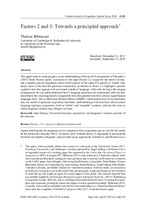| dc.contributor.author | Biberauer, Theresa | |
| dc.date.accessioned | 2021-07-09T09:41:56Z | |
| dc.date.available | 2021-07-09T09:41:56Z | |
| dc.date.issued | 2019 | |
| dc.identifier.citation | Biberauer, T. (2019). Factors 2 and 3: Towards a principled approach. Catalan Journal of Linguistics, 2019(269752), 45–88. https://doi.org/10.5565/REV/CATJL.219 | en_US |
| dc.identifier.issn | 2014-9719 | |
| dc.identifier.uri | https://doi.org/10.5565/rev/catjl.219 | |
| dc.identifier.uri | http://hdl.handle.net/10566/6387 | |
| dc.description.abstract | This paper seeks to make progress in our understanding of the non-UG components of Chomsky’s (2005) Three Factors model. In relation to the input (Factor 2), I argue for the need to formu-late a suitably precise hypothesis about which aspects of the input will qualify as ‘intake’ and, hence, serve as the basis for grammar construction. In relation to Factor 3, I highlight a specific cognitive bias that appears well motivated outside of language, while also having wide-ranging consequences for our understanding of how I-language grammars are constructed, and why they should have the crosslinguistically comparable form that generativists have always argued human languages have. This is Maximise Minimal Means (MMM). I demonstrate how its incorporation into our model of grammar acquisition facilitates understanding of diverse facts about natural language typology, acquisition, both in “stable” and “unstable” contexts, and also the ways in which linguistic systems may change over time. | en_US |
| dc.language.iso | en | en_US |
| dc.publisher | Universitat Autònoma de Barcelona | en_US |
| dc.subject | Three factors | en_US |
| dc.subject | Universal grammar | en_US |
| dc.subject | Acquisition | en_US |
| dc.subject | Crosslinguistic variation | en_US |
| dc.subject | Poverty of the stimulus | en_US |
| dc.title | Factors 2 and 3: Towards a principled approach | en_US |
| dc.type | Article | en_US |

